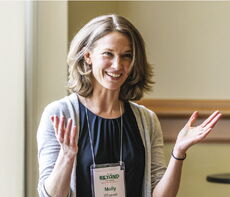
Many jobs at Maine nonprofits don't pay a living wage, new study says
 File photo / COURTESY THE BOULOS CO
After nearly 30 years on Congress Street in Portland, the Maine Association of Nonprofits moved to new headquarters at 30 Danforth St. this spring.
File photo / COURTESY THE BOULOS CO
After nearly 30 years on Congress Street in Portland, the Maine Association of Nonprofits moved to new headquarters at 30 Danforth St. this spring.
Wages for almost every job at Maine nonprofits have risen, on average, faster than inflation over the past two years.
But the pay for roughly 20% of nonprofit job categories in the state still lags behind living-wage levels.
That's especially true for receptionists, part-time volunteer coordinators, day care teachers, direct care workers, cooks, drivers and custodians, according to a report released by the Maine Association of Nonprofits.
The report, “Nonprofit Wages + Benefits in Northern New England, Maine Edition,” is based on data collected from 788 nonprofits across Maine, New Hampshire and Vermont from April to June this year.
The report includes key findings on workforce trends, wages, benefits and regional comparison.
The association conducts the compensation study every two years. It’s intended to act as a resource the nonprofits can use to inform conversations about the nonprofit workforce.
$14B impact
According to the report, Maine nonprofits employ one in six workers, or about 100,000 people, and contribute more than $14 billion to the economy each year.

“Compensation is an important part of attracting and retaining talented individuals to the work communities across Maine rely on nonprofits to deliver: educating our children, protecting our natural environment, nurturing our spirits through the arts, creating affordable housing, encouraging community connection and recreation, caring for vulnerable neighbors and much, much more,” said Molly O’Connell, the association’s assistant director.
She continued, “Nonprofits report vacancies for direct care positions like these, which are often critical to our community safety net, at the highest rates.”
Key findings
In the 2024 data sample, 83% of positions included at least some reported wages that were below a “living wage calculator,” developed by the Massachusetts Institute of Technology, for a single, childless adult in Maine.
Salary competition remains the top hiring challenge, affecting almost 60% of participating organizations. But 26% said lack of affordable housing was also a barrier to hiring and retention.
Some organizations said they are implementing more equity practices in their hiring processes, through strategies such as providing salary and wage transparency and using cost of living research.
Employer contributions to employee retirement savings saw a substantial gain, with 67% of organizations reporting financial contributions this year, compared to 49% in 2018.
More nonprofit employers in Maine pay 100% of employee health coverage than do those in New Hampshire and Vermont, even though the majority of organizations that offer health insurance reported an increase in health care benefits costs during their last renewal period.
“To provide equitable compensation aligned with the costs of living in our communities, nonprofits need our partners in government and philanthropy to understand and invest in what it takes to sustain a healthy nonprofit workforce,” said Jennifer Hutchins, the association’s executive director.
To view the full report, click here.














0 Comments